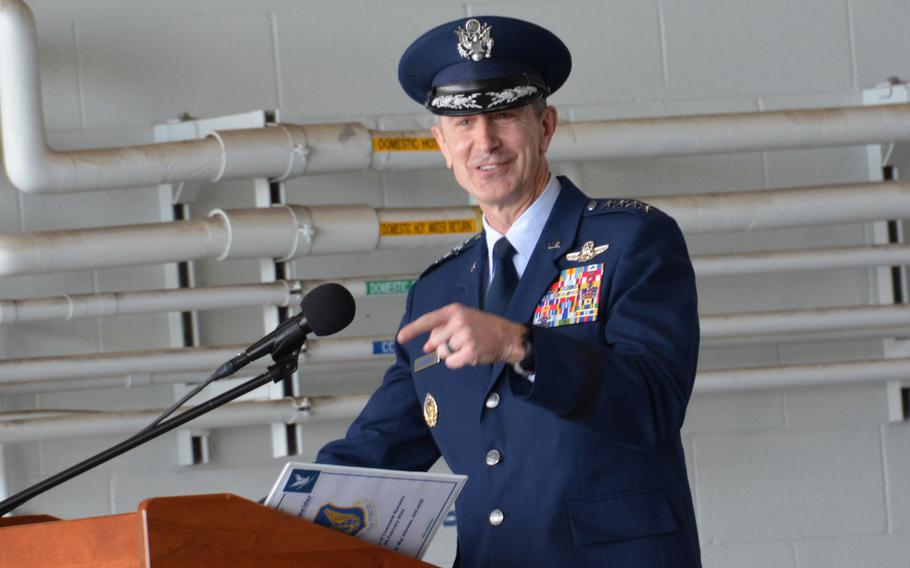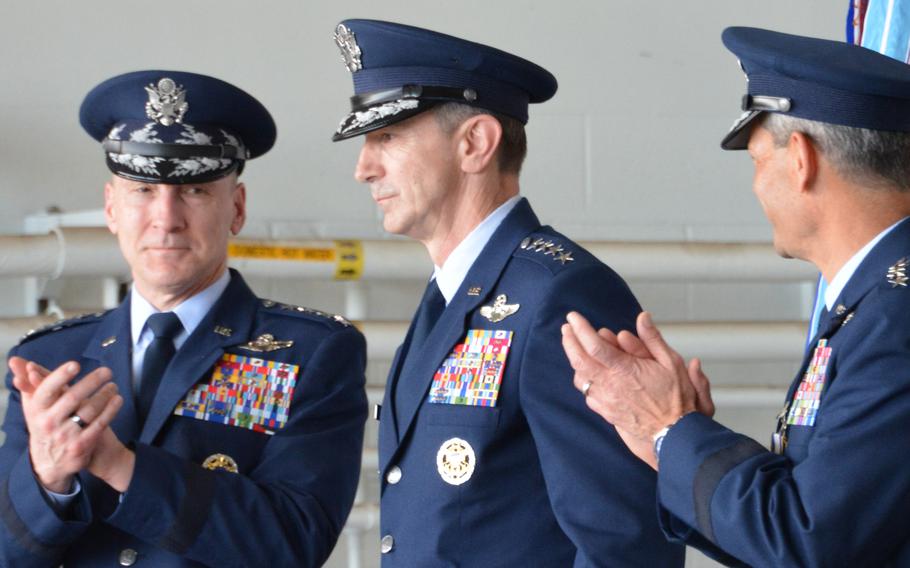
Gen. Kevin Schneider addresses the audience during ceremony at Joint Base Pearl Harbor-Hickam on Feb. 9, 2024, in which he assumed command of Pacific Air Forces. (Wyatt Olson/Stars and Stripes)
JOINT BASE PEARL HARBOR-HICKAM, Hawaii — An Air Force fighter pilot who has spent a third of his 36-year career in the Indo-Pacific took command of Pacific Air Forces during a ceremony Friday in a hangar beside Hickam Airfield, Hawaii.
Gen. Kevin “Gumby” Schneider, who received his fourth star the same day, took the reins from Gen. Ken Wilsbach, who now heads to Langley Air Force Base, Va., to head Air Combat Command.
Gen. David Allvin, Air Force Chief of Staff, told the audience he was confident Schneider, with his deep experience in the region, would transition well into the new job.
“He understands the value of partnerships that need to be sustained and enhanced,” Allvin said. “He understands airpower in the Pacific.”
Schneider also understands the “challenges and sometimes the frustrations” of dealing with the Pentagon, Allvin said. “But he also understands that there’s a way that one can work with the Pentagon to ensure that we continue the momentum to find what this theater needs.”
Schneider was most recently director of staff at Headquarters Air Force in the Pentagon.
As 31st PACAF commander, Schneider oversees almost 46,000 military and civilian personnel, with major installations in Hawaii, Alaska, Japan, South Korea and Guam. About 350 aircraft are assigned to the command.
“Having spent a third of my career and over a third of my life in the Indo-Pacific, this feels like coming home — because it is,” Schneider told the audience. “PACAF is where I learned to be a mission ready fighter pilot, developing the warfighting skills and deep appreciation for tactical teamwork that carried me throughout my career.”
From 2019 to 2021, he commanded U.S. Forces Japan out of Yokota Air Base, Japan.
Schneider’s previous Indo-Pacific assignments include chief of staff at U.S. Indo-Pacific Command and chief of staff at PACAF.

Gen. David Allvin, left, and Gen. Ken Wilsbach, right, applaud Gen. Kevin Schneider after he assumed command of Pacific Air Forces during a ceremony at Joint Base Pearl Harbor-Hickam, Hawaii, on Feb. 9, 2024. (Wyatt Olson/Stars and Stripes)
Volatile region
Schneider recollected his first operational assignment in 1990 as an F-16 instructor pilot with the 36th Fighter Squadron at Osan Air Base, South Korea.
“And since that first tour in 1990, I have served in the Indo-Pacific many times, and over the decades, I have watched the security situation in the region change,” he said. “It has become more interconnected. It has become more challenging. It has become more severe. And it now carries a far higher potential for volatility.”
Today, America and its allies and partners in the region face actors “who work to undermine the rules-based international order” through “economic coercion, political bullying and military aggression,” Schneider said, alluding to China’s disputes claims of sovereignty in the South China Sea and its increasingly assertive military.
Adm. John Aquilino, commander of U.S. Indo-Pacific Command, told the audience that Schneider’s “experience in this theater is critical to us.”
The commander of PACAF is “responsible to provide combat airpower across half the globe in an instant’s call,” Aquilino said.
‘Path to the future’
Aquilino and Allvin praised Wilsbach for developing the Air Force’s agile combat employment concept, or ACE, during his command of PACAF since 2020.
ACE moves the Air Force away from a conventional style of warfare “characterized by stationary air bases and predictable battlefields,” the Air Force said in a June news release.
“The Air Force recognizes the need for flexibility and resilience in the face of emerging threats that demand rapid response and distributed operations,” the news release stated. “ACE revolutionizes how airpower is projected and sustained in contested environments.”
“As we’re adjusting to the national defense strategy and adjusting our Air Force and our joint force to meet the challenges, there are new concepts required, new schemes of maneuver that we need to investigate and mature and bring to the field,” Allvin said.
Among those is agile combat employment, which Allvin described as “the path to the future.”
Wilsbach did “a remarkable job” in “advocating and showing the rationale” for ACE and moving it beyond concept to implementation, he said.
“We know we have more work to do, but without [Wilsbach’s] work, we wouldn’t have secured the one-plus billion dollars that’s going to support that scheme that is critical for the air component to support INDOPACOM,” he said.